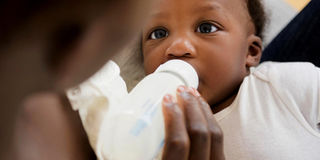Tips for bottle feeding your baby

Even with bottle feeding, a mother can express breast milk and feed that to the baby instead of formula milk. Net Photo
It is recommended that a mother breastfeeds her baby exclusively for six months and thereafter introduce solid foods. However, a number of mothers find themselves with no other option due to their working schedules.
According to Lydia Pedun Aisu, a nutritionist at International Fertiliser Development Centre, the more a mother breast feeds her child, the more breast milk they will produce. So, even in circumstances where a mother must resort to bottle feeding, she can still express her breastmilk and bypass the cost of buying formula milk.
For eight months, Racheal Angom, a social worker and mother of two has expressed breastmilk for her child.
“I do not know the cost of buying formula milk. Also, I believe that the child gets more nutrients from breast milk. By the time I go home in the evening, my breasts are so full that I first express what my baby will take the next day then I take enough fluids to get enough breast milk for the night,” she says.
Pedun recommends that all working mothers teach all caretakers the best practices of bottle feeding because if it is not done the right way, the child is likely to suffer from constipation, diarrhoea, skin rash and food poisoning, among other complications.
The bottles
Washing the feeding bottles in water and a detergent is not enough due to bacteria buildup. You need to sterilise them using a steamer.
Pedun says, “You can also put them in boiling water and let them boil for about two minutes.
Alternatively, you can pour some water in the bottle and microwave them for about two seconds.”
This, however, requires that you check the material and quality of the bottles. Check if the brand you have is a reputable one that is BPA free since this chemical is said to leach into the children’s food yet it is cancerous.
“While assembling the bottles, minimise the touches on the nipples to prevent contamination. Choose softer nipples to help the children to transition easily from the nipple of the breast to that of the bottle. Some children refuse to feed on the bottles for this reason,” Angom warns.
The milk
Pedun commends mothers that can express breast milk instead of formula. However, if the mother has no option, she can buy reputable formula milk from a place they trust. She says, “Follow instructions on the tin about how to mix and do not mix less or more because the nutrition value has been calculated.”
The milk that remains after feeding the baby should not be used again. Pedun says. Also, you should never boil expressed breast milk because it alters its nutrients, says Amanda Tumwebaze, a nutritionist. “It should be given to the child at room temperature and if it has been kept in the fridge, pour hot water in a bowl then submerge the bottle in it until it reaches room temperature,” she says.
Quantity
Breastfeeding is a slow process where the child also takes part by suckling. However, bottle feeding is a fast process facilitated by gravity and the child makes no effort to suckle.
This increases the risk of obesity since the baby sometimes takes in more than what the gut can manage.
While using the bottle, you can use paced bottle feeding which mimics the flow of milk like the breast.
The child feeds while the bottle is perpendicular just like the breast instead of tilting it vertically.
In this type of feeding, the infant is in control of the feeding pace; it slows down the flow of milk allowing the baby to eat more slowly. Infants below a year can be taught to drink from a cup instead of a bottle.




